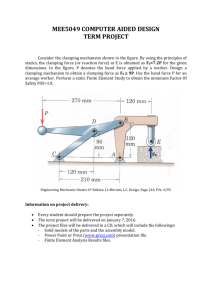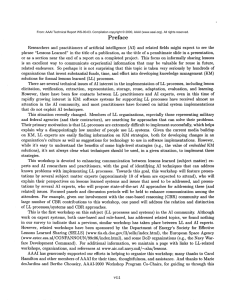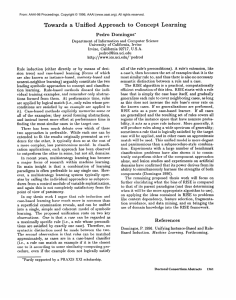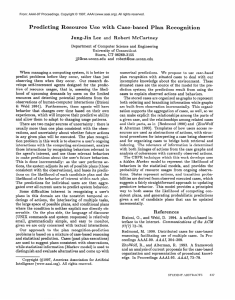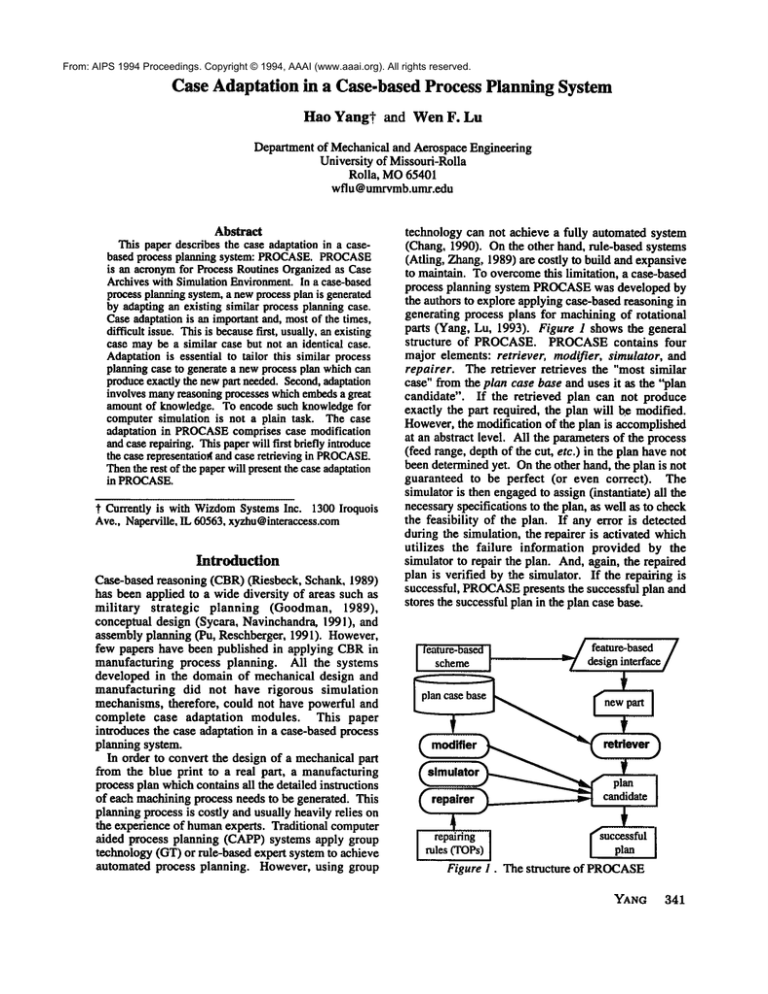
From: AIPS 1994 Proceedings. Copyright © 1994, AAAI (www.aaai.org). All rights reserved.
Case Adaptation in a Case.based Process Planning System
Hao Yang~ and Wen F. Lu
Department of Mechanical and Aerospace Engineering
University of Missouri-Rolla
Rolla, MO65401
wflu@umrvmb.umr.edu
Abstract
This paper describes the case adaptation in a casebased process planning system: PROCASE.
PROCASE
is an acronymfor Process Routines Organizedas Case
Archiveswith SimulationEnvironment.In a case-based
processplanningsystem,a newprocessplan is generated
by adapting an existing similar process planningcase.
Case adaptationis an importantand, mostof the times,
difficult issue. Thisis becausefirst, usually, an existing
case maybe a similar case but not an identical case.
Adaptationis essential to tailor this similar process
planningcase to generate a newprocess plan whichcan
produceexactly the newpart needed.Second,adaptation
involves manyreasoningprocesses whichembedsa great
amountof knowledge. To encode such knowledgefor
computer simulation is not a plain task. The case
adaptation in PROCASE
comprises case modification
and caserepairing. Thispaperwill first briefly introduce
the case representar.iod and case retrieving in PROCASE.
Thenthe rest of the paperwill presentthe case adaptation
in PROCASE.
t Currently is with WizdomSystems Inc. 1300 Iroquois
Ave., Naperville, IL 60563, xyzhu@interaccess.com
Introduction
Case-based reasoning (CBR)(Riesbeck, Schank, 1989)
has been applied to a wide diversity of areas such as
military strategic
planning (Goodman, 1989),
conceptual design (Sycara, Navinchandra, 1991), and
assembly planning (Pu, Reschberger, 1991). However,
few papers have been published in applying CBRin
manufacturing process planning. All the systems
developed in the domain of mechanical design and
manufacturing did not have rigorous simulation
mechanisms, therefore, could not have powerful and
complete case adaptation modules. This paper
introduces the case adaptation in a case-based process
planning system.
In order to convert the design of a mechanical part
~omthe blue print to a real part, a manufacturing
process plan whichcontains all the detailed instructions
of each machiningprocess needs to be generated. This
planning process is costly and usually heavily relies on
the experience of humanexperts. Traditional computer
aided process planning (CAPP) systems apply group
technology (GT)or rule-based expert system to achieve
automated process planning. However, using group
technology can not achieve a fully automated system
(Chang, 1990). On the other hand, rule-based systems
(Atling, Zhang,1989) are costly to build and expansive
to maintain. To overcomethis limitation, a case-based
process planning system PROCASE
was developed by
the authors to explore applying case-based reasoning in
generating process plans for machining of rotational
parts (Yang, Lu, 1993). Figure 1 shows the general
structure
of PROCASE.PROCASEcontains four
major elements: retriever, modifier, simulator, and
repairer. The retriever retrieves the "most similar
case" from the plan case base and uses it as the "plan
candidate". If the retrieved plan can not produce
exactly the part required, the plan will be modified.
However,the modification of the plan is accomplished
at an abstract level. All the parameters of the process
(feed range, depth of the cut, etc.) in the plan have not
been determinedyet. Onthe other hand, the plan is not
guaranteed to be perfect (or even correct). The
simulator is then engagedto assign (instantiate) all the
necessaryspecifications to the plan, as well as to check
the feasibility of the plan. If any error is detected
during the simulation, the repairer is activated which
utilizes the failure information provided by the
simulator to repair the plan. And, again, the repaired
plan is verified by the simulator. If the repairing is
successful, PROCASE
presents the successful plan and
stores the successful plan in the plan case base.
feature-based
I
scheme
plan case base
roowp
I
modifier
repairer
[ ru~pairi(T~gs)
Figure I. The structure
plan
candidate
I plan
I
of PROCASE
YANG 341
From: AIPS 1994 Proceedings. Copyright © 1994, AAAI (www.aaai.org). All rights reserved.
An Introduction
of PROCASE
A feature-based representation scheme was developed
for PROCASE
to represent rotational parts (Yang, Lu,
Lin, 1992). Figure /3 in Appendix provides some
examples of the features used in this paper. In the
proposed part representation, each geometricfeature is
called a part primitive (or primitive for short) and is
assigned a unique code, called primitive code. Then, a
part can be described using a part description string (or
part string). A part string usually has a mainstring and
a sub-string. Themain-string is a list of part primitives
along the axial. A sub-string is also a list which may
contain keyways, holes, beat-treatment, etc. Each
cutting process is viewedas the removalof a geometric
feature from the current base material, and it is given a
code, called operation code. Since each of the
intermediate part status can also be represented with
part primitives, a process planning case is represented
with all the intermediate part strings with ares pointed
by operation codes and the clamping conditions.
Therefore, the causal relation of the part status and the
process can be represented symbolically. Figure 2
shows an example of partial process plan case. There
are two cutting processes involved: grooving and
chamfering, which changes the part states from
PD31_PD19
to PD31_PD17
and then
to
PD3 I_PDO7.
PROCASE
uses features as indices to retrieve a
similar case. The retriever calculates the similarity
between the two parts according to the primitives
contained in two parts. The similarity value is
calculated in two stages: static evaluation stage and
dynamicfactor adjustment stage (Yang, Lu, 1993).
the static evaluation stage, the similarity value is
calculated based solely on the geometric features
contained in two parts. In the dynamic factor
adjustmentstage, the similarity value calculated in the
static evaluation stage is adjusted through the subfeatures of the twoparts.
For simplicity, only the static similarity factor
calculation is introducedhere.
The static similarity equals:
similarity=
matched primitives in both main strings × 2
total primitives in both main strings
The matchedpart primitives are evaluated by largest
commonsequence (LCS).
Modification
of the RetrievedCase
The process plan that the retriever finds, usually, will
generate a part which has somefeatures that are wanted
and someother features that are not desired. Also,
some desired features
may be missing.
The
modification is to add and to delete someprocesses in
the plan so that the modified plan to makea part that
retains the wanted features, discards the unwanted
features and adds the missing features. The algorithm
342
POSTERS
PD3 I_PDI9
CDII
PD3 I_PDI7
PD3 I_PD07
(clamping
by chuck)
m
"" H
IJ
CD21
PD3 I_PDI9
CT.01 ~ ~ CD11 (grooving)
PD3 I_PDI7
PD3 I_PDI7
CL01
~p "4-"--"
CD21 (chamfering)
PD31_ D07
Figure 2. An exampleof partial process planning case
of case modification is not to be listed here due to the
limitation of the size of this paper. Theimplementation
detail of the modification is seen in (Yang, Lu, 1993).
Generally, if the modifier finds some features
(primitives) of the part that needto be addedto the part
of the retrieved plan, it first searches the modification
case base. which stores the previous successful
modification cases, to find an applicable modification
case. If it fails to find one in the modification case
base, it looks through the plan case base to find any
partial plan in the previous planning cases which can
be used to modifythe retrieved plan.
Simulation
A case-based planning system does not pretend to be
error free. The errors mayarise because of insufficient
(or wrong) information about the problem,
misjudgment in retrieval mechanism, or a faulty
adaptation rule or algorithm. PROCASE
establishes a
verification mechanismwhich can detect any fault in
the plan due to various reasons.
In PROCASE,the verification
is divided into
backwardand forward stages. First, in the backward
verification stage, the simulatorstarts t’~mthe finished
part and tries to fill the material "back" to the blank
stock so that the part "recovers" to its original formof
blank stock. The simulator assigns all the parameters
of the processes such as the length and the depth of the
cut or the facilities and the time to perform the heattreatment. This is known as instantiation.
The
instantiation has to be backward,because only the final
state of the part is knownand it contains all the details
of the desired part. Figure 3 gives an exampleof the
backward verification. The descendent part status
From: AIPS 1994 Proceedings. Copyright © 1994, AAAI (www.aaai.org). All rights reserved.
PX81 PD3 l_PD78_PD18 united with the process
C D0 1 results in the antecedent part status
PX81 PD31 PD18 (the bold case indicates
the
"active" features, whichmeansthese features are to be
changedin form or size in the current process). In the
backwardverification, the operation code, the initial
part status, and the resulting part status are the
antecedent part of a simulation rule. The consequent
part of the rule is a sequence of operations which will
assign the values (e.g. dimensions, hardness,
tolerances) to the original part status and the process
(operation).
After the backwardverification, the antecedent part
status of each process has been instantiated.
The
forward verification, whichgoes the opposite direction,
is then engaged to verify each process. The forward
verification
sounds redundant. However, it is
necessary in PROCASE,
because, forward verification
is a true simulation. In the forward verification stage,
starting from the stock materiel, the simulator simulates
every process against every intermediate part status.
Such a simulation knowledgeis more natural than the
backwardverification. Flaws of the plan are easier to
be detected due to the same reason. In PROCASE,
the
detected error is used to repair the plan. The forward
verification performsthe followingtasks: (1) It verifies
the feasibility of each manufacturing process, (2)
checks the clamping conditions and the machinability
condition, (3) It decides the actual precision and
surface finish the process can reach and (4) It counts
the total cost of the process plan.
Before backward
verification
~
Case Repairing
The structure of TOP(Thematic Organizing Packet)
adopted to achieve repairing in PROCASE.This
process is similar to the plan repairing in CHEF
developed by Kristian Hammond
(1986).
A repairing TOPin PROCASE
contains a failure
type, a set of therapies associated with this failure type
and the algorithms to apply the therapies. Mostof the
times, these repairing therapies are instructive rather
than decisive. They are tried one by one. Many
attempts, however, largely increase the chance of
repairing success. This is like a doctor to treat a
patient. Given certain symptoms, a doctor will try
certain medicines. If the medicines do not workin the
next few days, the doctor will change them to another
group of medicines.
The whole process of repairing is like this: The
simulator proceeds backwardverification first. If the
backwardverification passes successfully, the plan is
delivered to forward verification.
If the forward
verification is successful, the plan is output to the user.
Otherwise, the repairer is activated to repair the plan.
The error messagedetected in the forward simulation is
used as the index to find the repairing TOP. For
example(Figure 4), if the error messageis: process
blocked, not clampable, feature(BP_CL FE), which
means the process can not be proceeded, because the
feature is not clampable. The therapies under which
are: change clamping feature; change clamping
methods; and exchange process sequence.
TOP 1
failure
(process blocked,
type: BP_CL__FE damping, feature)
CD01
PX8 I_PD3 I_PDI8
4-
I
PX81_PD31__PD78__PD18
2.
backward
verification
method
I
Figure
4. An example
of a repairing
TOP
After backward
_~_
~ change_clamping
_~ verification
CDOI
PX8 I_PD3 I_PDI8
PX~PDI8
Figure 3. An example of backwardverification
What kind of failures PROCASE
might encounter?
For a machiningprocess, the failure mayoccur if the
material is too hard to cut. Also, failure mayoccur if
the clamping is applied on the surface that is to be
machinedor the feature is not clampable (Figure 5).
Failure mayoccur if the feature is not able to be
generated by the process.
Sometimes,the process is applicable. The failure can
not be detected until the end of the process, whenthe
finished part is comparedwith the desired part. If the
adapted plan can not produce the finished part which
meets all the specifications (e.g. dimension,tolerance,
surface finish, material property, etc.) of the desired
part, the plan is considereda failed plan. In order to
YANG
343
From: AIPS 1994 Proceedings. Copyright © 1994, AAAI (www.aaai.org). All rights reserved.
proh£s002
PD02_PD73_PD73_PC02
prohim007
Figure 5. An example of unclampable feature
detect the reasons existed in the early stage of the
machining processes, which finally result in a failed
plan, PROCASE
keeps the record of the precision
degrade in the whole simulation process. A warning
messagewill be generated whenany quality degrade is
detected. This warning message may be used to guide
the repairing process.
Currently, there are eleven possible failure types
(error messagesas well as warningmessages)collected
by PROCASE.
Five of them are error messages such
as the aforementioned BP CL_FE. Six of them are
warning messages. Real world problems may generate
muchmore error and warning messages. It takes time
to list all of them. As an experimental system,
PROCASE
is not going to develop a complete list of
the messagesbut rather a methodologyin dealing with
such problems.
An example
The following is an exampleintroduced to explain the
adaptation algorithm. The exampleis kept as simple as
possible to reduce the length of illustration.
Initially, there were seven cases in the case library.
Figure 6 showstwo finished parts of two of the seven
cases. The new part input to the system is shownin
Figure 7.
The retriever searches the case library and finds the
most similar part(with similarity 50%)and the process
plan case prochis007,
which is shown in Figure 8.
The modifier is activated to modifythe plan so that the
newplan will produce the new part.
The modification is to be made such that the part
primitive PD43in case prochis007
is substituted by
PC01. The modifier finds the process making PC01in
prochis002
(PROCASE knows the equivalence
between PC01 and PC02). The extracted process is
shownin Figure 9. This partial process is inserted to
prochi s 007 so that the modified process plan would
produce the part PC01_PD07. Figure 10 shows the
modified plan.
The modified plan is then delivered to backward
verification. In this ease, the backwardverification
went smoothly. However,in the forward verification,
an error is detected when the clamping is applied on
feature PC01(in FigurelO, the primitive code with
344
POSTERS
Figure 6. Cases in PROCASE
case library
PC01_PD07
Fi~ntre :A The new part
CL01
CL01
CL01
CL01
CL01
Po
l
~ # ~q--- CD01
PD31_PDI8
~ ~ TN01
PDI2_PD41
~ # ~ CD01
PD31_PDI8
~ ~ TN01
PDI2_PD41
~ # ~ CD21
PDI2_PD44
~ ~ TN01
PD43_PDI8
--4~ # ~ CDII
PD43PDI7
~ # ~-- CD21
PD43PD07
I
I
Figure8. Theretrieved mostsimilarcase
prochis007
bold faces are clamping features). The process is
blocked and an error messageBP_CL_FE
is sent to the
repairer.
Through the simulation error message BP CL FE,
the repairing TOPin Figure 4 is activated. Figure ll
depicts the flow of the repairing graphically. The
repairer applies each of the repairing therapies one by
one until the repairing succeeds. The first repairing
therapy ’change clamping feature’ does not succeed
because, although it is possible to movethe clamping
From: AIPS 1994 Proceedings. Copyright © 1994, AAAI (www.aaai.org). All rights reserved.
a)
PD02_PD73_PD73_PD41
..........
,
forward verification
e ¯ ¯
COO1
Unclampahle
~
CO01
PD41
CLO1-----b~ -.4----CC01
PC02
The ex~acted process
Figure ~ Theparfalplanisextractedfromcase
prochis002
Therapy 1
(Change dampingfeature)
b)
.o51 l l
CL01
CL01
CL01
CL01
CL01
~ # 41--- CD01
PD3 I_PDI
8
# ~ TN01
PDI2_PD41
~ ~ ..4_ CD01
PD31 PDI8
# ~-- TN01
PDI2_PD41
~ # -.4.-- CC01
PDI2_PC02
$ ~ TN01
PC01_PD18
~ ~ ~ CDII
PC01_PDI7
~ # ~ CD21
PCOI_PD07
~
Unable to
machine
I ~
I U
~
I i
Therapy 2
(Change clamping method)
c)
I
I
~_............... _8
Figure
]0. The plan modified
from
prochis007,
(The bold cases show the
clamping features)
from feature PC01to feature PD18,this feature itself
is active feature, which meansit is to be machinedso
that clamping and machining conflict. The second
repairing therapy ’change clamping’ failed because
clamping method2 (one side clamp by chuck, one side
center hole holding) and clamping method 3 (center
hole holding at both ends) need center hole(s) being
machined first. Then the repairer starts the third
repairing therapy in the TOP: ’exchange machining
sequence’. This therapy starts the repairing from the
process blocked, then it exchangethe process with the
next process in the process plan until forwardverifica-
<~
d)
I¢--
~ No center hole, no one
ease is applicable
Therapy 3
(Exchange machining sequence)
e ¯ e
moo
COO1
E>
I
-7
i
I...................
[~> ccol
Figure ! 1. Anexampleof the flow of repairing
tion returns OK.This repairing therapy works in this
case. Theresulted plan is listed in Figure12.
YANG 345
From: AIPS 1994 Proceedings. Copyright © 1994, AAAI (www.aaai.org). All rights reserved.
PDSl
CL01 ~ $ "~-" CD01
PD31_PDI8
$ "~--- TN01
PDI2_PD41
CL01~
~ ~ CD01
PD31_PDI8
CL01 --b~ # "4-- CDII
PD31_PDI7
~
CL01
# "41"- CD21
PD31_PD07
~ "4-- TN01
PD03_PD41
CL01~
# ~ CC01
PD03_PC02
Figure 12. The repaired plan
Conclusions
The nature of process planning is case based. Process
planning is a very promising application area for casebased reasoning. Howeverthere is sparse study in this
area. PROCASE
is a system developed by the authors
in an attempt to apply the theory of case-based
reasoning in manufacturing process planning. This
paper introduced the case adaptation in PROCASE.
It should be pointed out that the case adaptation
algorithm developed in PROCASE
was largely inspired
by Kristian Hammond’swork in case-based planning
(CHEF) (Hammond, 1986). Certainly, most of
issues addressed in CHEFare applicable to other
planning systems. Although the implementation of the
theory is very application specific, the readers might
find many parallelisms between PROCASE
and CHEF.
The result of the testing system is saticfactory.
However, in order to implement a real world casebased process planning system, a muchbigger system
is expected to achieve a sophisticated system.
Appendix
The following (Figure 13) are somepart primitives and
their codes introducedin the paper.
The following are some cutting processes and a
clamping operation as well as their operation codes
introducedin this paper.
1. CD21-> cut a chamfer(Figure 2, 8, I0, 12).
2. CDll -> cut a groove (Figure 2, 8, It), 12).
3. CD01-> peripheral cut (turning) (Figure 3, 8,
I0, 12).
4. CC01-> cut a cone shape (Figure 9, I0, 11,
12).
5. CL01 -> clamping by chuck, from left
(Figure8, 9, 10, 12).
346 POSTERS
PDSl
PDS4
PD41
PD31
PD78
PXSI
PD07
PD02
PDI2
PDI7
PDI8
PDI9
I
q
PD73
PD43
PD41
PC01
PC02
Figure 13. Somepart primitives and their codes
introducedin this paper.
References
Atling, L., and H. Zhang, 1989. "Computer Aided
Process Planning: the State-of-the-art," International
Journal of Production Research, 27(4): 553-585.
Chang, T.C. 1990. Expert Process Planning for
Mam!facturing. Addison-Wesley
Goodman, M., 1989. "CBR in battle planning",
Proceedings of the DARPAWorkshop on Case-based
Reasoning, Pensocola Beach, FL, : 363-373
Hammond,K.J., 1986. Case-based Planning: An
Integrated Theory of Planning, Learning and Memory,
Ph.D. diss., Dept. of Computer Science, Yale
University
Pu, P. and M. Reschberger, 1991. "Case-based
Assembly Planning", Proceedings of Case-based
Reasoning workshop, Washington, D.C., : 245-254
Riesbeck, Christopher K. and Roger C. Schank, 1989.
Inside Case-Based Reasoning, Lawrence Erlbaum
AssociatesInc.,
Sycara, K. and D. Navinchandra, 1991. "Influences: A
Thematic Abstraction for Creative Use of Multiple
Cases", Proceedings of Case-based Reasoning
workshop, Washington, D.C., : 133-144
Yang, Hao, & Wen F. Lu, 1993. "PROCASE: A
Prototype of Intelligent Case-based Process Planning
System with Simulation Environment", Computers in
Engineer 1993 (ASME),San Diego, CA, : 571-577
Yang, Hao, Wen F. Lu and Alan C. Lin, 1992. "A
Frame Work for Using Case-based Reasoning in
AutomatedProcess Planning", Proc. of Winter Annual
Meeting, ASME,PED-Vol.95, : 101-114

